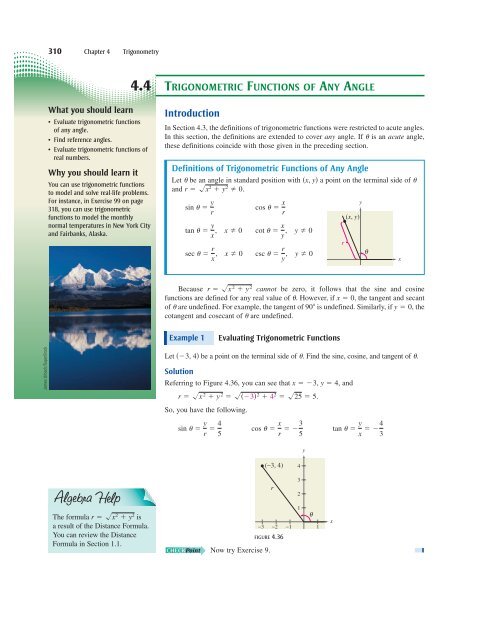Download this document - Toolbox PRO V2
Download this document - Toolbox PRO V2
Download this document - Toolbox PRO V2
Create successful ePaper yourself
Turn your PDF publications into a flip-book with our unique Google optimized e-Paper software.
310 Chapter 4 Trigonometry<br />
4.4 TRIGONOMETRIC FUNCTIONS OF ANY ANGLE<br />
What you should learn<br />
• Evaluate trigonometric functions<br />
of any angle.<br />
• Find reference angles.<br />
• Evaluate trigonometric functions of<br />
real numbers.<br />
Why you should learn it<br />
You can use trigonometric functions<br />
to model and solve real-life problems.<br />
For instance, in Exercise 99 on page<br />
318, you can use trigonometric<br />
functions to model the monthly<br />
normal temperatures in New York City<br />
and Fairbanks, Alaska.<br />
Introduction<br />
In Section 4.3, the definitions of trigonometric functions were restricted to acute angles.<br />
In <strong>this</strong> section, the definitions are extended to cover any angle. If is an acute angle,<br />
these definitions coincide with those given in the preceding section.<br />
Definitions of Trigonometric Functions of Any Angle<br />
Let be an angle in standard position with x, y a point on the terminal side of<br />
and r x 2 y 2 0.<br />
<br />
y<br />
sin<br />
cos x r<br />
( x, y)<br />
tan y x , x 0<br />
sec<br />
y r<br />
cot x y , y 0<br />
r x , x 0<br />
csc r y , y 0<br />
r<br />
<br />
θ<br />
x<br />
<br />
Because r x 2 y 2 cannot be zero, it follows that the sine and cosine<br />
functions are defined for any real value of . However, if x 0, the tangent and secant<br />
of are undefined. For example, the tangent of 90 is undefined. Similarly, if y 0, the<br />
cotangent and cosecant of are undefined.<br />
<br />
<br />
Example 1<br />
Evaluating Trigonometric Functions<br />
James Urbach/SuperStock<br />
Let 3, 4 be a point on the terminal side of . Find the sine, cosine, and tangent of .<br />
Solution<br />
Referring to Figure 4.36, you can see that x 3, y 4, and<br />
r x 2 y 2 3 2 4 2 25 5.<br />
So, you have the following.<br />
sin<br />
y r 4 5<br />
cos<br />
x r 3 5<br />
tan<br />
y x 4 3<br />
y<br />
( −3, 4)<br />
r<br />
4<br />
3<br />
2<br />
The formula r x 2 y 2 is<br />
a result of the Distance Formula.<br />
You can review the Distance<br />
Formula in Section 1.1.<br />
Now try Exercise 9.<br />
1<br />
θ<br />
−3 −2 −1 1<br />
FIGURE 4.36<br />
x



